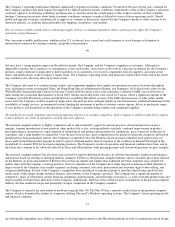Apple 2003 Annual Report Download - page 31
Download and view the complete annual report
Please find page 31 of the 2003 Apple annual report below. You can navigate through the pages in the report by either clicking on the pages listed below, or by using the keyword search tool below to find specific information within the annual report.
Accounting for Stock-Based Compensation
The Company currently measures compensation expense for its employee stock-based compensation plans using the intrinsic value method
prescribed by Accounting Principles Board (APB) Opinion No. 25,
36
Accounting for Stock Issued to Employees
and provides pro forma disclosures of the effect on net income and earnings per share as if the fair
value-based method had been applied in measuring compensation expense. The Company has elected to follow APB Opinion No. 25 because,
as further discussed in Part II, Item 8 of this Form 10-K at Note 1 of the Notes to Consolidated Financial Statements, the alternative fair value
accounting provided for under SFAS No. 123, Accounting for Stock-Based Compensation , requires use of option valuation models that were
not developed for use in valuing employee stock options and employee stock purchase plan shares. Under APB Opinion No. 25, when the
exercise price of the Company's employee stock options equals the market price of the underlying stock on the date of the grant, no
compensation expense is recognized.
The FASB decided on April 22, 2003 to require all companies to expense the value of employee stock options. Companies will be required to
measure the cost of employee stock options according to their fair value. The FASB has indicated that it plans to issue in the first quarter of
calendar year 2004 an exposure draft of a new accounting standard addressing this matter. Prior to issuance of this exposure draft, the FASB
has indicated it will be addressing several significant technical issues. Among other things, the FASB must determine the extent to which the
new accounting standard will permit adjustments to recognized expense for actual option forfeitures and actual performance outcomes. This
determination will affect the timing and amount of compensation expense recognized. Also, a method to determine the fair value of employee
stock options must be established. Current accounting standards require use of an option-pricing model, such as the Black-Scholes formula, to
determine fair value and provide guidance on adjusting some of the input factors used in the model. This valuation approach has received
significant criticism and may be subject to changes that could have a significant impact on the calculated fair value of employee stock options
under the new standard.
At the Company's annual shareholder's meeting on April 24, 2003, shareholders approved a proposal requesting that the Company's Board of
Directors (the Board) establish a policy of expensing the value of all future employee stock options issued by the Company. The Board and
management appreciate and take seriously the views expressed by the Company's shareholders. As discussed in the Company's Form 10-Q for
the period ended March 29, 2003, the Company had decided not to expense the value of employee stock options until the FASB finalizes its
new accounting standard on the matter. The Company based this decision on the FASB's announced intention to soon require all companies to
expense the value of employee stock options and the FASB's near-term review of technical issues that will play a significant role in
determining the fair value of and accounting for employee stock options. The Company monitors progress at the FASB and other developments
with respect to the general issue of employee stock compensation. In the future, should the Company expense the value of employee stock
options, either out of choice or due to new requirements issued by the FASB, the Company may have to recognize substantially more
compensation expense in future periods that could have a material adverse impact on the Company's future results of operations.
Recent Accounting Pronouncements
In January 2003, the FASB issued Interpretation No. 46 (FIN 46), Consolidation of Variable Interest Entities . FIN 46 clarifies the application
of Accounting Research Bulletin No. 51 and applied immediately to any variable interest entities created after January 31, 2003 and to variable
interest entities in which an interest is obtained after that date. For variable interest entities created or acquired prior to February 1, 2003, the
provisions of FIN 46 must be applied for the first interim or annual period beginning after December 15, 2003. The adoption of the provision of
FIN 46 related to variable interests created after January 31, 2003 did not have a material impact on the Company's results of operations or
financial position. The Company continues to evaluate the provisions of FIN 46, and does not believe that the adoption of the remaining
provisions will have a material impact on its results of operations or financial position.
37
In May 2003, the FASB's Emerging Issues Task Force (EITF) reached consensus on EITF Issue No. 00-21, Revenue Arrangements with
Multiple Deliverables
. EITF Issue No. 00-21 provides guidance on how to account for certain arrangements that involve the delivery or
performance of multiple products, services, and/or rights to use assets. The provisions of EITF Issue No. 00-21 apply to revenue transactions
entered into in fiscal periods beginning after June 15, 2003. Additionally, in August 2003, the EITF reached consensus on EITF Issue No. 03-
5,
Applicability of AICPA Statement of Position 97
-2, "Software Revenue Recognition," to Non-Software Deliverables in an Arrangement
Containing More-than-Incidental Software. EITF Issue No. 03-5 provides guidance on determining whether non-software deliverables are
included within the scope of SOP 97-2, and accordingly, whether multiple element arrangements are to be accounted for in accordance with
EITF Issue No. 00-21 or SOP 97-2. The Company currently applies the requirements of SOP No. 97-2 when accounting for all multiple
element transactions. The Company does not anticipate the application of either EITF Issue Nos. 00-21 or 03-5 will have a significant impact
on its results of operations or financial position.
























